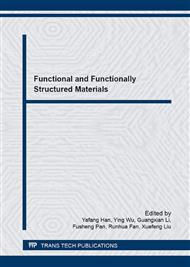p.167
p.174
p.179
p.184
p.189
p.196
p.205
p.210
p.217
Preparation and Characterization of Structural Damping Composites Toughened by Polyamide Nonwoven Fabrics
Abstract:
A new kind of structural damping composites was prepared by interleaving polyamide nonwoven fabrics (PNF) between the carbon fiber reinforced epoxy composite laminates. The damping behaviors of the composites made were experimentally investigated using cantilever beam test and dynamic mechanical analysis. The damping ratios of the nonwoven fabrics interleaved composites were compared with the ones of non-interleaved composites. In addition, the interlaminar shear strength and flexible modulus of the composites were also investigated, as well as the composite compression after impact (CAI), Mode I and Mode II interlaminar fracture toughness (GIC and GIIC), in order to evaluate the influence of the polyamide nonwoven fabric layers on the composite mechanical properties. It has been observed that the interleaved polyamide nonwoven fabric layers greatly improved the composite damping loss factors, and the composites containing 7 layers of PNF showed the best damping behavior. Meanwhile, the addition of PNF showed a negligible influence on the composite flexible strength and modulus and interlaminar shear strength. Most importantly, the CAI, GIC and GIIC tests indicated that the composite interlaminar toughness and impact resistance were significantly improved by the interleaved PNF. Finally, the reinforcing mechanism of this kind of composites is discussed.
Info:
Periodical:
Pages:
189-195
Citation:
Online since:
March 2016
Authors:
Price:
Сopyright:
© 2016 Trans Tech Publications Ltd. All Rights Reserved
Share:
Citation:


